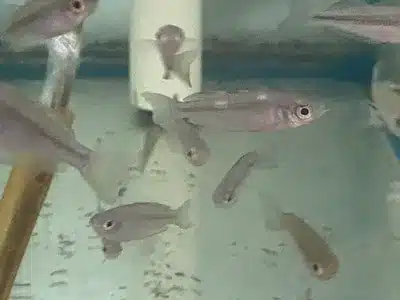Hello, Glad You Found Us, Let Us Help.
WELCOME TO PJS DISEASE/PARASITIC AILMENTS
There's much to see here. So, take your time, look around, and will always be expanding this info. We hope you enjoy our site.
STEP 1 - Below is a comprehensive list with descriptions, pictures, meds, and notes on ailments to help diagnose.
STEP 2 - Go to CHEMOTHERAPY OF AQUATICS for a list of chemicals, drugs, and uses.
CHILODONELLA
Additional Information
Chilodonella is a protozoan ciliate that parasitizes the skin and gills. The back of the head to the dorsal fin seems to be the main target, and this makes it easier to notice and identify. If in the gills much more difficult to notice, yet a tell-tale sign is hanging just under the surface, gasping for air. This is one of the most common issues for the aquarist, and they never even know it. Stores obtain their livestock directly from the farms, which grow them in open-air ponds and facilities, making livestock more susceptible. The stock is not being treated for the proper duration to eradicate this bug completely from the host. Remember, one becomes two, two becomes four, four becomes eight, and so on until, in time, it's critical.
Identification – Clearly delineated, whitish, translucent areas measuring 1 to 3mm appear on the skin and/or hanging near the surface, gasping for air.
Reproduction - By division into two. Stages, .5 t to 1.0mm round/elliptical spots on the skin become cloudy. Then, the skin thickens in those defined areas, and the color fades to white. Then they disintegrate, swarming into your tank, infesting everything.
Causes – You brought it in.
Treatments – Acriflavine. Malachite Green and methylene Blue can be used individually or in combination. Salt baths work if caught soon enough; some fish may not tolerate high-level salt baths.
Preferred - ICK OFF (Malachite green in Formalin 37%) in conjunction with Methylene Blue every other day for 10 days.
Notes – This bug can swim, and they reproduce by division; a heavily stocked tank is very susceptible to being overrun unless caught in time.

COLUMNARIS DISEASE
Acclimation Information
Columnaris Disease is a frequent disease in the aquarium; it is caused by the bacterium Flexibacter columnaris. It can be most stubborn to eradicate and can reproduce at an alarming rate, able to take out a heavily populated tank in 72 hours. Treatment is possible, but only over a long period of time. So timing is key, and treatment must be implemented quickly for success. Also known as Mouth rot, Bacterial gill rot.
Identification – At the onset, small whitish spots on the snout, edges of scales, and/or fins. As it progresses, it takes on the appearance of mold or fungus. The fins rays will start to disintegrate, leaving them bare, exposing the fish to a fungal infection. If the gills get affected, the gill filaments will disintegrate from the tip to the gill arch. This causes the filaments to stick together from swelling and extra mucus/slime production; thus, the supply of oxygen is cut off or reduced, forcing rapid breathing.
Reproduction - Two forms of columnaris disease. Once the white areas gradually grow, the fish will die in a few days. Two of the white spots spread visibly inside for several hours, decimating everything. Higher temperature accelerates the reproduction.
Causes – hitched a ride on something, poor water quality, high ammonia, low oxygen.
Treatments – Chloramphenicol (Chloromycetin), but hard to get and administer, needs to be dissolved in ethyl alcohol to be administered; it does not dissolve in water. It can be injected.
Acriflavine
Notes – A

ICHTHYOPHTHIRIUS
Additional Information
Ichthyophthirius is an external parasite and can be most stubborn to eradicate due to its multi stage life cycle, but its life cycle is predictable, so timing is key to success.
Identification – A
Reproduction -
Causes – A
Treatments – A
Notes – A
